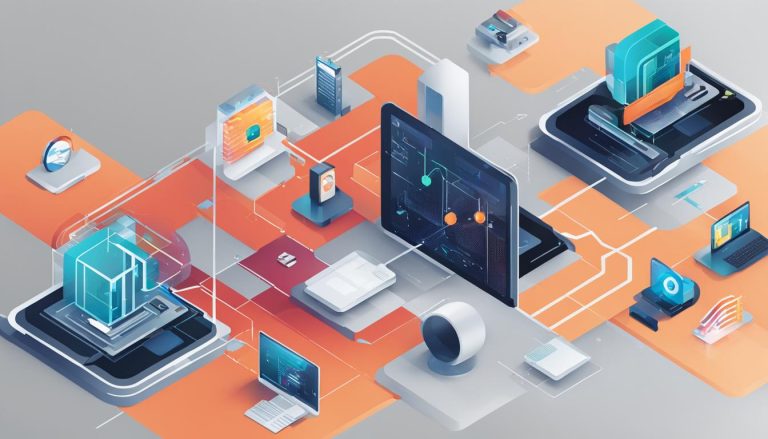A boot loader is a crucial component in the realm of computers and operating systems. It is responsible for initiating the loading of the operating system into the computer’s memory. The boot loader’s primary task is to load the kernel, the core of the operating system, into the computer’s RAM. It also plays a role in managing multiple operating systems on a computer, allowing users to choose between different operating systems during the boot process. Understanding the basics and functions of a boot loader is essential in comprehending the boot process and how the operating system starts up.
Key Takeaways:
- A boot loader initiates the loading of the operating system into the computer’s memory.
- The boot loader’s primary task is to load the kernel, the core of the operating system.
- It manages multiple operating systems on a computer, allowing users to choose between them during the boot process.
- Understanding the boot loader is essential in comprehending the boot process and how the operating system starts up.
The Prelude to Power On: Power-On Self-Test (POST)
When a computer is powered on, it goes through a series of checks and preparations known as the Power-On Self-Test (POST). This process involves the motherboard and CPU ensuring that essential hardware components are operational. The POST verifies the functionality of components such as the RAM, hard drive, and graphics card before proceeding to the next stage of the boot process. Understanding the POST is fundamental in grasping the initial steps of the computer power on process.
During the POST, the computer performs a series of diagnostic tests to verify that all the hardware components are functioning correctly. These tests include checking the integrity of the RAM by performing a memory test, ensuring that the hard drive is accessible and free from errors, and verifying that the graphics card is communicating with the motherboard. The POST also checks for the presence of peripheral devices such as keyboards and mice.
Once the POST is complete and all the hardware components have passed the diagnostic tests, the computer proceeds to the next stage of the boot process. This stage involves locating and loading the operating system into the computer’s memory. The POST plays a crucial role in ensuring that the computer is in a suitable state to begin the boot process and initiate the operating system.
| POST Steps | Description |
|---|---|
| RAM Test | The POST performs a memory test to check the integrity of the computer’s RAM. |
| Hard Drive Check | The POST verifies that the hard drive is accessible and free from errors. |
| Graphics Card Test | The POST checks that the graphics card is communicating with the motherboard. |
| Peripheral Device Check | The POST ensures that peripheral devices such as keyboards and mice are connected and functioning correctly. |
The Power-On Self-Test (POST) is a crucial part of the computer power on process, as it verifies the functionality of essential hardware components. Understanding the POST helps in comprehending the initial steps of the boot process and the role it plays in preparing the computer for the loading of the operating system.
By successfully completing the Power-On Self-Test, the computer ensures that all the necessary hardware components are functioning correctly. This allows the boot process to proceed smoothly, leading to the loading of the operating system and the eventual startup of the computer. The POST is a crucial process in initiating the power on sequence and ensuring the computer is ready for use.
Seeking the Operating System: Storage Device and Software
Once the Power-On Self-Test (POST) is completed, the computer embarks on its quest to locate the operating system. The operating system is the software that enables users to interact with the computer, and it is essential for the computer’s functionality. The search for the operating system begins by accessing a specific segment on a storage device, such as a hard drive or a solid-state drive. The boot loader, a crucial component in the boot process, plays a significant role in facilitating the loading of the operating system into the computer’s memory.
Understanding the relationship between the boot loader and the operating system is key to comprehending the intricacies of the boot process. The boot loader acts as a bridge between the hardware and the software, providing the necessary instructions and resources for the operating system to initialize successfully. It ensures that the operating system is loaded into the computer’s memory, enabling users to interact with their devices.
The choice of storage device can also impact the boot process. Traditional hard drives (HDD) and solid-state drives (SSD) are commonly used storage media. Hard drives store data magnetically on rotating disks, while solid-state drives use flash memory. SSDs provide faster access times and improved overall system performance compared to HDDs. However, both types of storage devices can be used to hold the operating system and other data.
Comparison between Hard Drives and Solid-State Drives:
| Aspect | Hard Drives (HDD) | Solid-State Drives (SSD) |
|---|---|---|
| Speed | Slower access times | Faster access times |
| Noise | Audible mechanical noise due to moving parts | No moving parts, silent operation |
| Reliability | Prone to mechanical failures | More durable with no mechanical parts |
| Power Consumption | Higher power consumption | Lower power consumption |
Choosing the appropriate storage device depends on factors such as budget, performance requirements, and personal preferences. Regardless of the storage device used, the boot loader plays a crucial role in the boot process, ensuring the successful loading of the operating system and enabling users to experience the full functionality of their computers.
Master Boot Record (MBR) and GUID Partition Table (GPT)
When it comes to disk partitioning, two prominent methods have emerged: the Master Boot Record (MBR) and the GUID Partition Table (GPT). These two approaches serve as the foundation for organizing and managing partitions on storage devices. While the MBR has been widely used in legacy systems, modern systems have embraced the more advanced and flexible GPT.
The Master Boot Record (MBR) is a legacy disk partitioning scheme that has been in use since the early days of personal computing. It resides in the initial sector of a storage device and contains crucial information about the disk’s partition structure. The MBR uses a 32-bit partition table, which limits the number of partitions to four primary partitions or three primary partitions and one extended partition.
In contrast, the GUID Partition Table (GPT) is a more modern and robust partitioning scheme. It was introduced as part of the Unified Extensible Firmware Interface (UEFI) specification to overcome the limitations of the MBR. The GPT uses a 64-bit partition table, allowing for a significantly larger number of partitions. Additionally, GPT provides enhanced data integrity through redundant partition information and supports larger storage devices with capacities exceeding 2 terabytes.
It’s important to note that while GPT offers numerous advantages over MBR, there are still situations where MBR is preferred. For example, MBR is compatible with a wider range of operating systems, including older versions that do not support GPT. Additionally, some legacy systems and computer hardware may only support MBR, making it necessary to use this partitioning scheme.
In summary, the choice between MBR and GPT depends on various factors such as the system’s requirements, operating system compatibility, and hardware support. Understanding the differences between these two partitioning schemes is crucial in managing and configuring storage devices for optimal performance and compatibility.
The Boot Loader’s Dilemma: Multiple Operating Systems
When it comes to managing multiple operating systems, the boot loader plays a crucial role in orchestrating the boot process. Its primary function is to present users with a menu, allowing them to choose their preferred operating system during startup. This feature is particularly important in multi-boot environments, where users may have different operating systems installed on their computer.
By presenting a selection of operating systems, the boot loader ensures that users have the flexibility to switch between different environments based on their needs. Whether it’s a choice between Windows and Linux or macOS and Ubuntu, the boot loader facilitates the loading of the selected operating system into the computer’s memory, enabling a smooth transition from the boot process to the operating system itself.
Having the ability to select an operating system directly from the boot loader provides users with convenience and flexibility, eliminating the need to manually configure the boot process each time they want to switch between operating systems. This functionality is especially beneficial for individuals who need to work with different operating systems for various tasks or projects.
Overall, understanding how the boot loader handles multiple operating systems is essential in comprehending the intricacies of the boot process. By seamlessly coordinating the loading of different operating systems, the boot loader ensures a smooth and efficient transition from startup to the operating system of choice.
Table: Comparing Boot Loaders
| Boot Loader | Features | Compatibility |
|---|---|---|
| GRUB | Configurable menu, support for various file systems | Linux, Windows, macOS |
| Windows Boot Manager | Intuitive interface, integration with Windows operating systems | Windows |
| Clover Bootloader | Support for Hackintosh systems, custom configurations | macOS |
The Kernel’s Rise to Power: Initializing System Components and Device Drivers
As the boot loader completes its task, the kernel emerges as the supreme commander, orchestrating the computer’s awakening. With its role as the operating system’s core, the kernel takes charge of initializing various system components and ensuring that each part of the computer is ready for action.
During system initialization, the kernel coordinates the activation of crucial elements such as the processor, memory, and input/output devices. It sets up the necessary data structures and establishes communication channels between different components, enabling seamless interaction among them. This initialization process establishes a solid foundation for the smooth operation of the operating system.
In addition to system initialization, the kernel plays a vital role in loading and managing device drivers. Device drivers are specialized programs that allow the operating system to communicate effectively with hardware components such as printers, graphics cards, and network interfaces. The kernel handles the loading and unloading of device drivers, ensuring that the correct drivers are available for each connected peripheral.
“The kernel acts as the mediator between the operating system and the hardware, bridging the gap to enable successful communication. With its responsibility for system initialization and device driver management, the kernel holds the key to unlocking the full potential of the computer’s hardware.”
Table: Key Steps in Kernel Initialization
| Step | Description |
|---|---|
| 1 | Hardware Detection |
| 2 | Processor Initialization |
| 3 | Memory Management |
| 4 | Device Initialization |
| 5 | File System Initialization |
| 6 | Process Control Initialization |
The kernel’s role in system initialization and device driver loading is paramount in ensuring the proper functioning of the operating system and its seamless integration with the computer’s hardware. By overseeing these critical tasks, the kernel paves the way for the execution of applications, enabling users to harness the full potential of their computing devices.
Conclusion: Decoding the Boot Block
As I reach the end of this exploration into the boot process, I am reminded of the critical role played by the boot block. Consisting of the boot loader, MBR or GPT, and the kernel, the boot block sets the stage for the initiation of the operating system. The boot loader acts as the bridge between the kernel and the computer’s memory, loading the kernel and breathing life into the operating system.
Throughout this journey, we have dissected the intricate steps involved in the boot process. From the initial Power-On Self-Test (POST) to the search for the operating system and the selection of multiple operating systems, each stage plays a vital role in bringing the computer to life.
By understanding the complexities of the boot block, we gain a deeper appreciation for the silent actors working behind the scenes. The boot loader, along with the MBR or GPT and the kernel, orchestrates the digital spectacle that unfolds before our eyes. It is through their collaboration that we are able to access the functionality of the operating system and harness the power of our computers.
In conclusion, the boot block is the foundation upon which the boot process and the operating system depend. By unraveling its mysteries, we gain insight into the inner workings of our computers and the magic that happens every time we power them on.
FAQ
What is a boot loader?
A boot loader is a crucial component responsible for initiating the loading of the operating system into the computer’s memory.
What is the Power-On Self-Test (POST)?
The Power-On Self-Test is a series of checks and preparations that the computer goes through upon powering on, ensuring the functionality of essential hardware components.
How does the boot loader facilitate the loading of the operating system?
The boot loader plays a critical role in locating and loading the operating system into the computer’s memory from a storage device.
What are the differences between the Master Boot Record (MBR) and the GUID Partition Table (GPT)?
The MBR and GPT are different approaches to disk partitioning, with legacy systems using MBR and modern systems embracing GPT for a more advanced and flexible partitioning structure.
How does the boot loader handle multiple operating systems?
The boot loader allows users to choose between different operating systems during the boot process, facilitating the loading of the selected operating system into the computer’s memory.
What is the role of the kernel in system initialization and device driver loading?
The kernel takes charge of initializing system components and loading device drivers, which enable effective communication between the operating system and hardware components.
What is the significance of the boot block in the boot process?
The boot block, comprised of the boot loader, MBR/GPT, and the kernel, serves as the catalyst for the boot process, initiating the loading of the operating system and orchestrating the computer’s startup.
Jana is a public relations specialist and writes about all kinds of software products that make our life easier.


